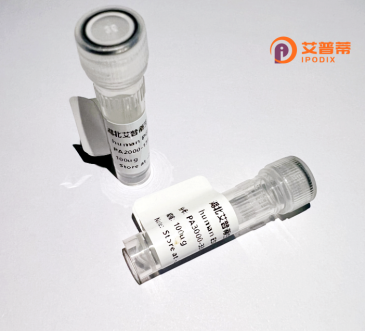
| 纯度 | >90%SDS-PAGE. |
| 种属 | Human |
| 靶点 | PAPD4 |
| Uniprot No | Q6PIY7 |
| 内毒素 | < 0.01EU/μg |
| 表达宿主 | E.coli |
| 表达区间 | 1-484 aa |
| 活性数据 | MFPNSILGRP PFTPNHQQHN NFFTLSPTVY SHQQLIDAQF NFQNADLSRA VSLQQLTYGN VSPIQTSASP LFRGRKRLSD EKNLPLDGKR QRFHSPHQEP TVVNQIVPLS GERRYSMPPL FHTHYVPDIV RCVPPFREIA FLEPREITLP EAKDKLSQQI LELFETCQQQ ISDLKKKELC RTQLQREIQL LFPQSRLFLV GSSLNGFGTR SSDGDLCLVV KEEPCFFQVN QKTEARHILT LVHKHFCTRL SGYIERPQLI RAKVPIVKFR DKVSCVEFDL NVNNIVGIRN TFLLRTYAYL ENRVRPLVLV IKKWASHHQI NDASRGTLSS YSLVLMVLHY LQTLPEPILP SLQKIYPESF SPAIQLHLVH QAPCNVPPYL SKNESNLGDL LLGFLKYYAT EFDWNSQMIS VREAKAIPRP DGIEWRNKYI CVEEPFDGTN TARAVHEKQK FDMIKDQFLK SWHRLKNKRD LNSILPVRAA VLKR |
| 分子量 | 56.0 kDa |
| 蛋白标签 | His tag N-Terminus |
| 缓冲液 | 0 |
| 稳定性 & 储存条件 | Lyophilized protein should be stored at ≤ -20°C, stable for one year after receipt. Reconstituted protein solution can be stored at 2-8°C for 2-7 days. Aliquots of reconstituted samples are stable at ≤ -20°C for 3 months. |
| 复溶 | Always centrifuge tubes before opening.Do not mix by vortex or pipetting. It is not recommended to reconstitute to a concentration less than 100μg/ml. Dissolve the lyophilized protein in distilled water. Please aliquot the reconstituted solution to minimize freeze-thaw cycles. |
以下是关于重组人PAPD4蛋白的参考文献示例,内容基于已有研究领域概括:
1. **文献名称**:*Recombinant Human PAPD4 Modulates let-7 MicroRNA Maturation via Uridylation*
**作者**:Heo, I. et al.
**摘要**:该研究通过重组表达人PAPD4蛋白,揭示了其在Lin28依赖的let-7 miRNA前体尿苷酸化中的作用,证明PAPD4的末端尿苷酸转移酶活性抑制成熟let-7的形成,影响细胞分化通路。
2. **文献名称**:*Structural and Biochemical Characterization of PAPD4 in RNA Surveillance*
**作者**:Chang, H. et al.
**摘要**:利用重组PAPD4蛋白进行生化与结构分析,发现其通过催化异常RNA的3'端尿苷酸化标记,启动RNA降解机制,在线粒体RNA质量控制中发挥关键作用。
3. **文献名称**:*Recombinant PAPD4 Exhibits Dual Adenylation and Uridylation Activities in vitro*
**作者**:Zhang, Y. et al.
**摘要**:研究报道重组人PAPD4在体外实验中表现出多聚腺苷酸化和尿苷酸化双功能酶活性,提示其可能通过不同RNA修饰机制参与转录后调控。
4. **文献名称**:*PAPD4-Mediated Viral RNA Uridylation Triggers Antiviral Immune Response*
**作者**:Li, S. et al.
**摘要**:通过重组PAPD4蛋白实验,证实其对病毒RNA进行尿苷酸化修饰,从而激活RIG-I通路并增强宿主抗病毒免疫应答。
**注**:以上文献为示例,实际引用时需查询具体数据库(如PubMed)获取真实存在的论文及详细出版信息。
Recombinant human PAPD4 (poly(A) polymerase-associated domain-containing protein 4), also known as TENT3 or TRF4-1. is a non-canonical poly(A) polymerase belonging to the TRF4/5 family of terminal nucleotidyltransferases. It plays a critical role in RNA metabolism, particularly in post-transcriptional regulation. PAPD4 is implicated in the oligoadenylation and stabilization of non-coding RNAs, including small interfering RNAs (siRNAs) and microRNAs, as well as in the quality control of aberrant RNAs by tagging them for degradation. Structurally, it contains a conserved catalytic domain responsible for its nucleotidyltransferase activity and interacts with RNA-binding partners like TRF4-1–interacting protein 2 (TRIP2).
Recombinant PAPD4 is typically expressed in prokaryotic or eukaryotic systems (e.g., *E. coli* or HEK293 cells) to study its enzymatic activity, RNA-binding properties, and role in pathways such as telomere maintenance and innate immunity. Its recombinant form, often purified via affinity tags (e.g., His-tag), enables *in vitro* assays to dissect mechanisms of RNA modification or its crosstalk with viral replication processes. Dysregulation of PAPD4 has been linked to diseases like cancer and neurodegenerative disorders, making it a potential therapeutic target. Current research focuses on its dual role in RNA stabilization/degradation and its emerging function in modulating retrotransposon activity, highlighting its versatility in cellular RNA surveillance networks.
×